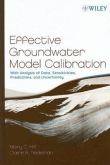Effective Groundwater Model Calibration : With Analysis
Hill, Mary C. / Tiedeman, Clai
Éditeur : À CONFIRMER
ISBN papier: 047177636X
Parution : 2007
Code produit : 1135347
Catégorisation :
Livres /
Science /
Mathématique /
Mathématiques
Formats disponibles
| Format | Qté. disp. | Prix* | Commander |
|---|---|---|---|
| Livre papier | En rupture de stock** |
Prix membre : 108,80 $ Prix non-membre : 116,99 $ |
*Les prix sont en dollars canadien. Taxes et frais de livraison en sus.
**Ce produits est en rupture de stock mais sera expédié dès qu'ils sera disponible.
Description
Methods and guidelines for developing and using mathematical models Turn to Effective Groundwater Model Calibration for a set of methods and guidelines that can help produce more accurate and transparent mathematical models. The models can represent groundwater flow and transport and other natural and engineered systems. Use this book and its extensive exercises to learn methods to fully exploit the data on hand, maximize the model's potential, and troubleshoot any problems that arise. Use the methods to perform: Sensitivity analysis to evaluate the information content of data Data assessment to identify (a) existing measurements that dominate model development and predictions and (b) potential measurements likely to improve the reliability of predictions Calibration to develop models that are consistent with the data in an optimal manner Uncertainty evaluation to quantify and communicate errors in simulated results that are often used to make important societal decisions Most of the methods are based on linear and nonlinear regression theory. Fourteen guidelines show the reader how to use the methods advantageously in practical situations. Exercises focus on a groundwater flow system and management problem, enabling readers to apply all the methods presented in the text. The exercises can be completed using the material provided in the book, or as hands-on computer exercises using instructions and files available on the text's accompanying Web site. Throughout the book, the authors stress the need for valid statistical concepts and easily understood presentation methods required to achieve well-tested, transparent models. Most of the examples and all of the exercises focus on simulating groundwater systems; other examples come from surface-water hydrology and geophysics. The methods and guidelines in the text are broadly applicable and can be used by students, researchers, and engineers to simulate many kinds systems.























